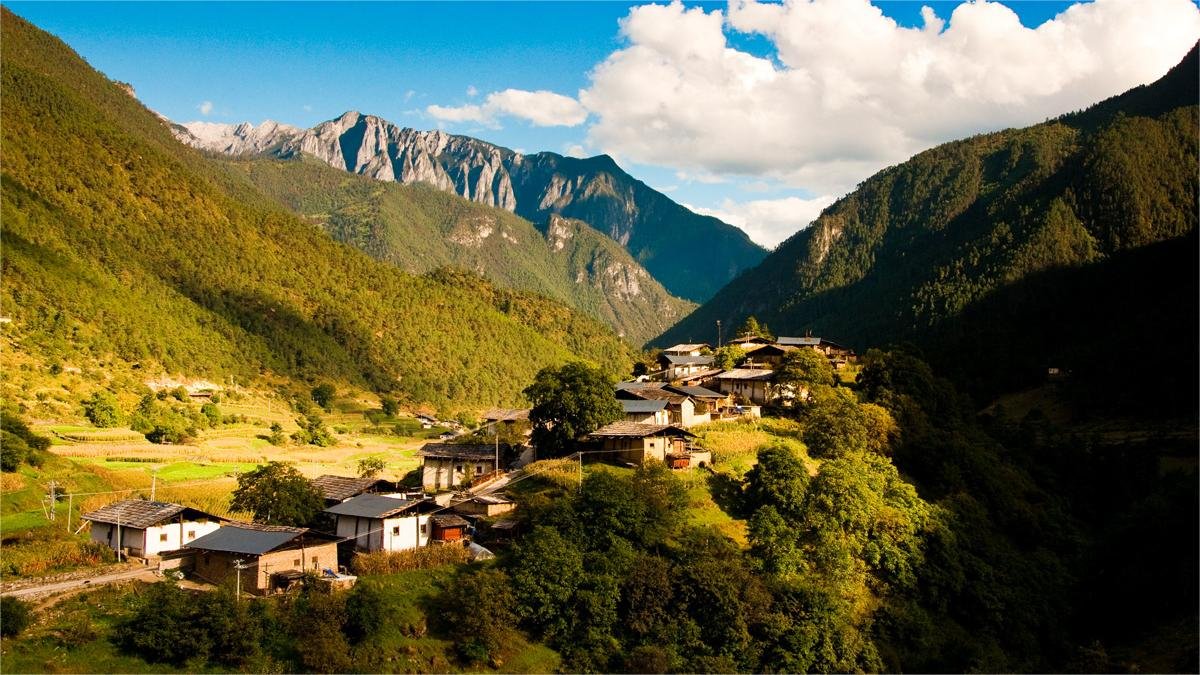Niru Village (尼汝村), encompassing an area of approximately 80 square kilometers and situated at an elevation of 2,705 meters, is often likened to the timeless and serene Shangri-La depicted in James Hilton’s novel “Lost Horizon.” This secluded Tibetan village, with its 108 households and population of 650 people, is a place where life follows the rhythm of nature, with residents rising with the sun and retiring at dusk.
Surrounded by dense, ancient forests that obscure the sky, Niru Village is home to extensive birch groves and towering spruces and firs. This isolation has preserved the village as a timeless enclave, untouched by modernity, and it is celebrated as one of China’s most pristine natural landscapes. Known as the “secret of secrets” and a “true paradise,” Niru is a place where visitors might wish to lose themselves forever, making it a favored destination for young adventurers and trekkers seeking an escape into nature.
Table of Contents
- Basic Information
- Location and Transportation
- Highlights of Niru Village
- Vlog abotu Niru Village
- Attractions near Niru Village
Basic Information
| Estimated Length of Tour | 1 – 3 days |
| Ticket Price | Free |
| Opening Hours | 24 hours a day throughout the year |
Location and Transportation
Niru Village is located in Luoji Township, Shangri-La City, in the Diqing Tibetan Autonomous Prefecture of Yunnan Province. It is part of the “Three Parallel Rivers of Yunnan Protected Areas,” a UNESCO World Heritage Site known for its stunning natural landscapes and unique ecological features. To reach Niru Village, you have two main routes to choose from:
Zhongdian (Shangri-La) to Luoji Township to Niru Village:
- By Bus: From Zhongdian (Shangri-La) Bus Station, there are two daily buses to Luoji Township, one in the morning and one in the afternoon. The distance from Zhongdian to Luoji Township is about 80 kilometers, with a fare of around 20 yuan.
- By Car: Once you arrive in Luoji Township, you can hire a car to take you to Niru Village, which is about 30 kilometers away. The cost of hiring a car ranges from 150 to 200 yuan.
Zhongdian (Shangri-La) to Shudu Lake to Niru Village:
- By Car: From Zhongdian, you can hire a car to Shudu Lake, which is about 30 kilometers away.
- By Horseback: From Shudu Lake, you can either hike or ride a horse for the remaining 30 kilometers to Niru Village. Most visitors opt to ride a horse, which can be rented from local Tibetan residents at Shudu Lake. The horse owners usually serve as guides as well. The cost of renting a horse is typically between 80 and 100 yuan for a one-way trip.
Highlights of Niru Village
Local Festivals

Niru Village is rich in Tibetan culture and traditions, which are vividly expressed through its local festivals. These include the “Plowing Festival” on the 15th day of the second lunar month, the “Water Deity Festival” on the 15th day of the fourth lunar month, the “Danba Festival” on the 15th day of the seventh lunar month, and the “Mountain God Festival and Horse Race” on the 15th day of the ninth lunar month. Additionally, the Niru Guozhuang dance is a significant cultural activity during these celebrations and religious rituals.
Beautiful Trekking Routes

The village boasts a wealth of tourist attractions, including the ancient Tibetan village itself, the Nanbao Pasture, the Qicai Waterfall, the Diji Pasture, and the Pamna Immortal Cave. The trekking routes in Niru are among the most beautiful in the Diqing Prefecture, rivaling those of Meili Snow Mountain’s Yubeng Village, Haba Snow Mountain, Tiger Leaping Gorge, Baima Snow Mountain, Balagezong, and Qianhu Mountain.
A typical trek through the Nanbao and Diji pastures takes about three days. Due to the rugged terrain and high altitudes – often exceeding 3,800 meters – many sections require travelers to dismount and proceed on foot. Accommodation in the mountains is sparse, with only a few rudimentary shelters built by herdsmen. Trekkers are advised to bring tents, sleeping bags, and ample supplies, particularly high-calorie foods and medications like rhodiola to mitigate altitude sickness. Given the complex terrain, it is crucial to stay with a guide and avoid venturing alone.




